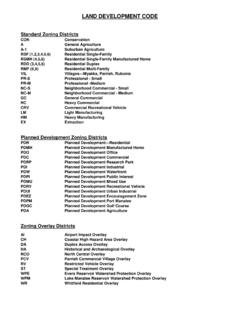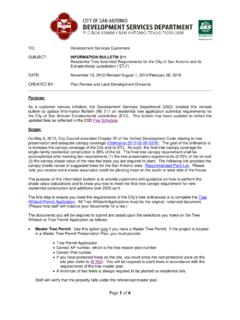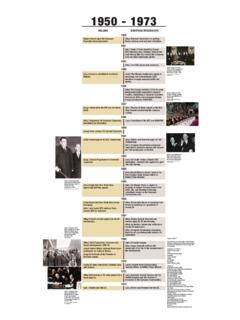Transcription of CONTENTS
1 Tair whiti Resource Management Plan Part C (C1-C4) Last Updated 18 December 2018 i CONTENTS C1 AIR QUALITY .. 1 AIR QUALITY MANAGEMENT ISSUES IN THE GISBORNE REGION .. 1 Introduction to Issues .. 1 Tangata Whenua Issues .. 1 Discharges of odorous or visual contaminants have the potential to cause adverse effects on sites and resources of significance to tangata whenua .. 1 The air is a taonga and needs to be safeguarded .. 1 Discharges of contaminants to air, particularly hazardous pollutants and particulate matter, have the potential to cause adverse effects to the health of the tangata whenua of the Gisborne region 1 Ambient Air Issues .. 2 Discharges to air cause, or have the potential to cause, reduction in the quality of ambient air .. 2 There is a lack of adequate data and information on ambient air quality, contaminants in discharges and climatic effects in the Gisborne region .. 2 General Air Quality Management Issues.
2 2 Hazardous air contaminants have the potential to cause serious and significant adverse effects on human, flora and fauna health and ecosystem integrity .. 2 Odorous discharges to air can result in temporary or prolonged adverse effects on human health and well-being, amenity values and the natural character of the coastal environment, wetlands, rivers, lakes and their margins .. 3 Discharges of smoke, dust and other particulate into the air have the potential to cause adverse effects on human health and on amenity values in localised areas of the region .. 3 Discharges to air have the potential to cause adverse effects on receiving environments within the Gisborne region that are potentially sensitive to those discharges .. 4 Spray Application of Agrichemicals .. 4 Discharges to air from the application of agrichemicals, particularly when resulting in off-target spray drift, have the potential to cause adverse effects on human health, flora and fauna health, ecosystem integrity and on sensitive receiving environments in the region.
3 4 Discharge of Contaminants from Transport Sources .. 5 Engine emissions can result in adverse effects on human health, flora and fauna health and ecosystem integrity and are a major contributor to global warming .. 5 Discharges of Contaminants from Domestic Sources .. 6 Discharges to air from domestic sources, including home heating appliances, open fires and backyard burning, can adversely affect human health and reduce amenity of adjoining properties and present a health risk .. 6 Industrial or Trade Sources .. 6 Discharges of contaminants to air from industrial or trade premises can reduce amenity and adversely affect human health and flora and fauna .. 6 Global Issues .. 7 Discharges of certain contaminants to air in the Gisborne region have the potential to contribute to the greenhouse effect and ozone depletion .. 7 Air Issues in the coastal environment .. 8 OBJECTIVES FOR AIR QUALITY MANAGEMENT .. 8 Introduction .. 8 Objectives .. 8 POLICIES.
4 9 Introduction .. 9 Policies for tangata whenua .. 9 Tair whiti Resource Management Plan Part C (C1-C4) Last Updated 18 December 2018 ii Policies for the Management of Ambient Air Quality .. 9 General Policies for Controlling Discharges of Contaminants to Air .. 9 Policies for Specific Sources of Discharges .. 11 Policies for Air Discharges to the coastal environment .. 13 METHODS .. 16 AIR QUALITY MANAGEMENT RULES .. 21 Introduction .. 21 Users Guide .. 21 Noxious, dangerous, offensive and objectionable effects .. 21 Rules for Discharges to Air .. 22 General Standards .. 22 Rules for Air Discharges in Coastal Environment .. 36 C2 BUILT ENVIRONMENT, INFRASTRUCTURE AND ENERGY .. 37 INFRASTRUCTURE, WORKS AND SERVICES .. 37 Introduction .. 37 Issues .. 38 Objectives (Infrastructure) .. 38 Policies .. 39 Policies: (Network Utility Operations) .. 39 Policies (Funding and Provision of Infrastructure) .. 40 Policies (Design and Reticulation of Infrastructure).
5 41 Policies (Structure Plans) .. 41 Policies (Works and Services) .. 42 Methods .. 45 Rules for Network utility activities .. 47 General Standards .. 48 Rules for Provision of Infrastructure for Development (Works and Services) .. 54 General Standards .. 54 Assessment Criteria .. 63 Rules for Activities within and adjacent to the Airport .. 67 General Standards .. 67 Financial Contributions .. 69 Financial Contributions for Water, Wastewater, Stormwater and Land Transport Infrastructure .. 69 Financial Contributions of Land for 69 Financial Contributions for Parking .. 70 PAPAKAINGA AND MARAE SETTLEMENTS .. 75 Introduction .. 75 Issues .. 75 Objectives .. 75 Policies .. 76 Methods .. 77 Rules for Papakainga and Marae Settlements .. 78 C3 COASTAL MANAGEMENT .. 82 INTRODUCTION .. 82 Matters of National Importance .. 82 ISSUE NATURAL CHARACTER .. 82 Issue .. 83 Objectives .. 83 Tair whiti Resource Management Plan Part C (C1-C4) Last Updated 18 December 2018 iii Policies.
6 83 Methods .. 86 ISSUE PROTECTING OUTSTANDING NATURAL FEATURES AND LANDSCAPES FROM INAPPROPRIATE 88 Issue .. 89 Objectives .. 89 Policies .. 89 Methods .. 91 ISSUE PROTECTING AREAS OF SIGNIFICANT INDIGENOUS VEGETATION AND SIGNIFICANT HABITATS OF INDIGENOUS FAUNA FROM INAPPROPRIATE ACTIVITIES .. 92 Issue .. 93 Objectives .. 93 Policies .. 94 Methods .. 95 ISSUE MAINTAINING AND ENHANCING PUBLIC ACCESS TO AND ALONG THE COASTAL MARINE AREA AND LAKES AND RIVERS IN THE COASTAL ENVIRONMENT .. 96 Issue .. 97 Objectives .. 97 Policies .. 97 Methods .. 100 ISSUE TANGATA WHENUA .. 102 Issue .. 102 Objectives .. 102 Policies .. 103 Methods .. 105 ACTIVITIES: STRUCTURES .. 107 Issues .. 108 Objectives .. 109 Policies .. 110 Methods .. 113 ACTIVITIES OCCUPATION OF SPACE .. 114 Issues .. 115 Objectives .. 115 Policies .. 116 Methods .. 117 ACTIVITIES ALTERATION OF THE FORESHORE AND SEABED .. 117 Issues .. 117 Objectives.
7 118 Policies .. 118 ACTIVITIES DISCHARGES .. 120 Issues .. 121 Objectives .. 121 Policies .. 122 Methods .. 126 ACTIVITIES TAKE, USE, DAM, DIVERT WATER .. 128 Issue .. 128 Objectives .. 128 Policies .. 129 ACTIVITIES EXOTIC PLANTS .. 129 Issue .. 130 Objectives .. 130 Policies .. 130 Tair whiti Resource Management Plan Part C (C1-C4) Last Updated 18 December 2018 iv Methods .. 131 ACTIVITIES COASTAL RECREATION .. 131 Issues .. 132 Objectives .. 132 Policies .. 132 Methods .. 133 COASTAL ENVIRONMENT OVERLAY .. 134 Objective .. 134 Policies .. 134 Rules for Coastal Environment Overlay .. 135 General Standards .. 135 COASTAL FINANCIAL CONTRIBUTIONS AND OCCUPATION RENTS .. 140 Financial Contributions .. 140 Introduction .. 140 Issue Residual Effects .. 141 Objective .. 141 Policy .. 141 Coastal Occupation Rents .. 143 Issue Fees .. 144 Objective .. 144 Policy .. 144 C4 CULTURAL AND HISTORIC HERITAGE.
8 145 CULTURAL HERITAGE .. 145 Introduction .. 145 Issue .. 146 General Objective .. 146 General Policy .. 146 Objectives (Heritage Alert Layer Overlay 1, Archaeological Sites and Areas Overlay 2)146 Policies (Heritage Alert Layer Overlay 1, Archaeological Sites and Areas Overlay 2) .. 146 Objectives (Waahi Tapu and Waahi Tapu Areas Schedule Overlay 3) .. 148 Policies (Waahi Tapu and Waahi Tapu Areas Schedule Overlay 3) .. 148 Objectives (Category A, B and C post European Contact and Central Business District Schedules Overlay 4) .. 148 Policies (Category A, B and C post European Contact and Central Business District Schedules Overlay 4) .. 149 Methods .. 151 Rules for Cultural Heritage Overlays .. 155 General Standards .. 155 Financial Contributions .. 158 Financial Contribution of Land for Protection of an Archaeological Site .. 158 Tair whiti Resource Management Plan Part C (C1-C4) Last Updated 18 December 2018 1 C1 AIR QUALITY C1 provisions are regional plan provisions.
9 Regional Plan Part C1 is operative. Air Quality Management Issues in the Gisborne region Introduction to Issues Air is a very dynamic medium. It provides interfaces with every receiving environment, including land, sea, freshwater, vegetation and animals, including the human body. The interactions between receiving environments and the chemicals discharged into and transported by air are very complex and do not fall neatly into categories of effect, discharge activity or contaminant. This section focuses on those issues that are significant within the Gisborne region. Air quality issues are also discussed in the RPS provisions of the Plan in Part B2. Tangata Whenua Issues Discharges of odorous or visual contaminants have the potential to cause adverse effects on sites and resources of significance to tangata whenua Air contaminants may adversely affect waahi tapu. Objectionable odours or visible contaminants may violate the sacredness of these sites or other places or features of significance to tangata whenua.
10 Objective (4)1. Policy The air is a taonga and needs to be safeguarded The air, like other natural and physical resources, is considered by tangata whenua to be a taonga, to be valued, used with respect and passed on intact to the next generation. The principle of kaitiakitanga in environmental terms provides for restoration of ecological systems, restoration of ecological harmony, increased usefulness of resources and reduces risk to present and future generations. Objective (4). Policy Discharges of contaminants to air, particularly hazardous pollutants and particulate matter, have the potential to cause adverse effects to the health of the tangata whenua of the Gisborne region Issues include: a) Effects of dust, including pollen, on community and individual water supplies; b) Effects of dust and pollen on the health of tangata whenua as a large proportion of the M ori population are affected by asthma and other bronchial ailments; c) Car exhaust fumes settling on edible vegetation close to roads; d) Spraying of horticultural blocks and pine plantations and the effects on human health; e) Incineration of human tissue.

![J1. Definitions [rps/rcp/rp/dp] - Auckland Council](/cache/preview/d/d/2/a/0/8/d/0/thumb-dd2a08d06e371f3ed80cf4e9fa2dd563.jpg)



